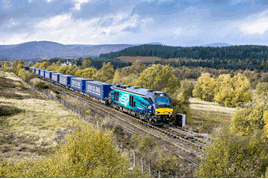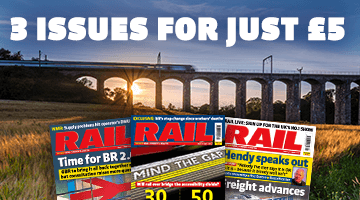So how does Scotland create the platform for growth and tackle the challenges the industry faces?
Transport Scotland cites “substantial natural resources, a highly skilled workforce, a long-standing reputation for innovation, an internationally recognised brand, sectors and companies that are competing at the highest level of international markets (particularly in the oil and gas and food and drink sectors), and exciting developments in emerging sectors such as offshore renewables”.
TS states: “To secure any modal shift and the long-term future of rail freight in Scotland, rail needs to be able to compete effectively with the use of road by heavy goods vehicles. Freight customers want a competitive price to transport their goods and a reliable and consistent service. The roads network is generally always accessible for freight.”
It suggests that some markets are simply not viable for rail freight traffic, and yet there are others (TS highlights transporting heavy bulk goods in long trains over even comparatively short distances) that remain a key strength and market opportunity for the sector.
However, between these extremes there’s a margin where strategic intervention can help change the relative economics between rail and other modes, and where an equivalent level of service can be offered.
The predicted rise to 26 million tonnes carried by 2043 is extracted from Network Rail’s Freight Market Study, published two years ago. However, at that time, the pace and severity of the coal sector decline was not known. TS suggests other markets have also shown a decline, although it believes that the predictions “do provide a useful indicator of the full market potential for rail freight in Scotland if certain conditions were met”.
So where are the market opportunities? TS believes that a number of opportunities for growth exist “where Scotland may hold a competitive advantage”. It highlights timber, whisky, bottled water, fish and meat, or where alternative forms of energy supplies such as biomass are required.
It also highlights that if freight is to grow, then new and expanded sub-sectors must be explored. These include intermodal markets, where TS says the potential for future growth is clear.
However, that depends on reducing the mileage threshold at which rail is competitive with road, while also supporting increased collaboration across modes.
Scotland has annual sales of food and drink of £8.3bn, and there is a suggestion that elements of this market remain untapped by rail, such as fish and meat. Currently a third of all finished whisky products move by rail, but TS believes that can grow. A trial was recently carried out moving spirits to Elgin, showing that this is possible.
Forestry products is another area for growth prospects. Every year millions of tonnes of timber travel across Scotland and beyond, and commercial forestry covers almost 14% of Scotland’s land area. There is a Scottish Government target to continue expanding the forest resource by 100,000 hectares by 2022.
Transporting timber is vital, yet the journey often starts on rural roads, and it is vital that all opportunities are sought to change this. Transport Scotland says that where there are economies of scale, rail can play a part.
Of course, rail access plays a part in this not always being possible, with feedback suggesting that in some rural regions access is difficult. The Highland Timber Transport group highlighted this and wants to use rail, but costs and infrastructure constraints have been cited as barriers. This is where innovation could help, but so far no details have emerged (although all parties are working on solutions).
In construction there is an unprecedented number of projects being delivered in Scotland, and Transport Scotland believes this is a huge opportunity for rail.
Elsewhere, TS says low-bulk haulage merits investigation. It suggests that parcels and food and drink products could be carried on passenger trains, particularly on key inter-city routes. It highlights the transportation of fresh shellfish on the Caledonian Sleeper from Inverness to London Euston.
“Building on examples like this could serve to complement growth in online shopping and the current expansion in parcel service providers in and around railway stations and major hubs across the country,” states TS.
It further highlights the possibilities thrown up by the use of ScotRail’s High Speed Train fleet from 2018, as well as Caledonian Sleeper’s new fleet of Mk 5s. “Within the scope of the Franchise Agreements we will work closely with the franchisees and the business community to explore the feasibility of potential options,” it states.
International markets are also key. Scottish international exports in 2013, excluding oil and gas, were provisionally estimated at £27.9bn, an increase of 7.2% from 2012. The largest exporting industries in 2013, as in previous years, were manufacture of food and beverages (18% of all exports) and manufacture of coke, refined petroleum and chemical products (12.6%).
Just under half of exports were destined for within the European Union, with the Netherlands the largest market, followed by Germany. There is not yet a clear picture as to how much moves by rail.
TS states: “Rail freight movements within Scotland cannot be considered in isolation. Current connections with the rest of the UK, the port network and Europe are crucial both now and to achieve growth potential.”
There is a concern that ports with access to rail do not use the market, while other ports have limited access. There are also no direct trains to the Channel Tunnel, due to insufficient volumes and technical constraints. This is deemed a lost opportunity.
Scottish Government research also reveals a lack of awareness among Scottish businesses, particularly small to medium-sized enterprises, about the potential benefits of using rail freight and how to access providers. Evidence suggests there is also a perception that accessing rail freight services is complex, particularly compared with the ease of putting a lorry onto the road network. TS says this echoes comments received from the rail industry itself.
Scottish Government wants freight to grow on rail…but these are challenging times. It won‘t be easy.
- This feature was published in RAIL 790 on December 23 2015
















Login to comment
Comments
FrankH - 09/02/2016 15:13
Coal from Scotland is down to a bare minimum now. Hunterston - Drax 1 usually, sometimes 2 trains a day. Killoch - Pennyfford (cement works) is as and when needed. Fiddlers Ferry trains have ceased. When Drax converts another generator to biomass Hunterston supplies will stop as Tyne/Immingham terminals are closer.
Alex Fisher - 19/02/2016 00:46
The SNP Government at Holyrood should be investing more in getting freight off the roads and on to the railways. The railway infrastructure needs upgraded such as the Perth to Inverness line to be doubled for the majority its length so as to allow for more paths for freight trains. Cities such Dundee see little freight traffic and other facilities are using old out dated equipment eg Coatbridge Freightliner terminal.
Niall Laybourne - 23/05/2016 20:50
£30m of assistance for a £30bn industry...£6bn for the A9 and A96 roads alone. Well done Scottish Government, I can feel your commitment to railfreight all the way from here in Caithness.